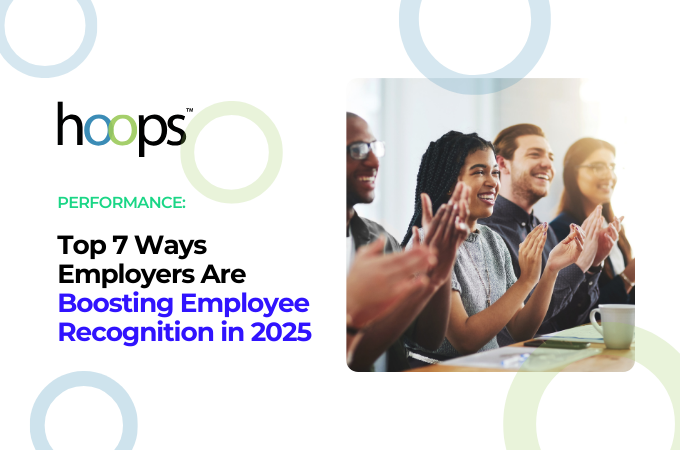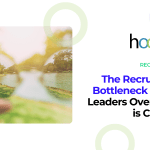In 2025, employee recognition is the secret sauce for business leaders—CEOs, CHROs, and HR executives—looking to ignite performance, retain top talent, and build a thriving workplace culture. At Hoops, we know that strategic employee recognition isn’t just about feel-good tactics; it’s a powerful driver of employee performance, aligning perfectly with our employee performance solutions. By rewarding top performers and fostering a high-functioning environment, companies can reach their workforce’s full potential while naturally phasing out underperformers.
This blog unveils the top seven ways employers are revolutionizing employee recognition in 2025, based on research-backed insights for C-suite and HR leaders. From AI-powered personalization to peer-driven celebrations, these strategies will help you elevate employee recognition and drive measurable results. Let’s dive in and explore how to make employee recognition your competitive edge.
Why Employee Recognition Matters in 2025
Employee recognition is a game-changer, and the data proves it. A 2024 Gallup study found that employees who receive regular recognition are 45% more likely to stay with their employer for the next two years or more. A McKinsey report adds that 67% of employees rank praise as a top motivator, outshining even financial bonuses. Yet, Gallup’s report reveals that only 22% feel they are getting the recognition they deserve. The result? Forbes finds that 66% of employees, especially your top performers, would quit if they feel underappreciated.
In a performance-driven culture, the 80/20 rule reigns supreme: focus 80% of your employee recognition efforts on your middle-to-top performers to keep them engaged and pushing boundaries. The bottom 20% will either rise to the challenge or naturally exit in a high-functioning environment. Here’s how leading employers are making employee recognition a cornerstone of their 2025 strategy.
1. Hyper-Personalized Rewards Tailored to Individual Needs
In 2025, generic rewards are obsolete. Leading employers use AI and market insights to deliver hyper-personalized employee recognition that resonates with individual priorities. A 2024 Mercer study shows employees prefer tailored benefits—like options between extra PTO, wellness stipends, or career development funds—over one-size-fits-all packages. Hoops’ Workforce Planning services harness AI-driven market insights and labor market forecasting to craft competitive, bias-free rewards that boost engagement and retention.
Why It Works: Personalized employee recognition fosters loyalty and boosts individual performance.
Actionable Tip: Leverage Hoops’ automated engagement surveys and market insights to design transparent, tailored rewards that keep your workforce motivated and aligned.
2. Performance-Based Pay for Top Performers
In 2025, employers are emphasizing employee recognition through performance-based pay, rewarding top performers who exceed expectations. According to a 2024 Paychex survey, 49% of employers are increasing pay for high performers, with bonuses tied directly to measurable outcomes.
Why It Works: Bonuses signal to top performers that their impact is seen and valued, while also setting a high bar for others. This creates a virtuous cycle where excellence is rewarded, and underperformers are incentivized to improve or move on.
Actionable Tip: Tie bonuses to clear KPIs, such as revenue growth or project milestones. Communicate transparently about how employee recognition aligns with performance goals to maintain fairness.
3. Equity Grants to Foster Ownership
Equity is no longer just for startups. In 2025, companies are using stock options and equity grants as a dynamic employee recognition tool to reward top performers and build ownership. A 2024 Grant Thornton article notes this trend is gaining momentum.
Example: Tech giants like Microsoft and mid-sized firms alike are offering restricted stock units (RSUs) to top performers, aligning their success with the company’s long-term growth.
Actionable Tip: Introduce tiered equity grants based on performance. Clearly communicate the value of equity in your employee recognition program to show its financial impact.
4. Expanded PTO and Mental Health Days
Time is the new currency. Employers in 2025 are recognizing employees by offering expanded paid time off (PTO) and dedicated mental health days to combat burnout. A SHRM article highlights the rise of paid leave and mental health benefits.
Why It Works: Generous PTO shows employees you value their well-being, which boosts loyalty and productivity. For top performers, it’s a reward that keeps them refreshed and ready to excel.
Actionable Tip:Offer a flexible PTO policy and tie it to performance goals for added impact. Promote this in employee recognition communications to reinforce a culture of trust.
5. Peer-to-Peer Recognition Platforms
Peer-to-peer (P2P) employee recognition is becoming more common, with platforms enabling real-time shoutouts and rewards. A Gallup study found employees who receive valuable peer feedback are 57% less likely to burn out and 48% less likely to seek new jobs.
Example: At Hoops, our quarterly “Core Value Awards” use peer nominations to celebrate teamwork or innovation, rewarding winners with gift cards and praise to drive performance.
Actionable Tip: Start a peer-to-peer employee recognition program with awards like “WOW Awards.” Use Hoops’ automated workflow surveys to collect nominations and share winners’ stories in meetings to inspire excellence.
6. Gamified Recognition for Engagement
Gamification is elevating employee recognition in 2025. Companies use leaderboards, badges, and challenges to make recognition engaging and competitive. A 2024 Forbes article notes that 90% of employees say gamification boosts their productivity.
Why It Works: Gamification taps into intrinsic motivation, encouraging excellence and teamwork, especially among younger workers.
Actionable Tip: Launch a gamified employee recognition program with monthly challenges tied to team goals. Reward winners with points redeemable for prizes or experiences.
7. Public Recognition During Company-Wide Events
Nothing says “you’re valued” like a spotlight moment. A SHRM article reveals that 81% of highly satisfied employees work in cultures of appreciation. In 2025, employers are amplifying employee recognition by celebrating top performers in town Halls, team meetings, and company-wide events.
Example: Google’s leadership showcases employees who drive innovation during all-hands meetings, using public praise to elevate morale and inspire a culture of excellence.
Actionable Tip: Schedule regular recognition moments in your all-hands meetings. Use storytelling to make employee recognition relatable, showcasing how individual efforts tie to company success.
The Bottom Line: Recognition Drives Performance
In 2025, employee recognition is a strategic imperative for business and people leaders. By leveraging personalized rewards, performance-based pay, equity, PTO, peer-to-peer platforms, gamification, and public recognition, employers can build a high-performing culture where top talent thrives and underperformers move on. The data is clear: prioritizing employee recognition reduces turnover, boosts engagement, and drives business success.
Want to assess your talent strategy? Take our Talent Health Checkup—a free, quick tool to identify gaps and gain actionable insights for 2025. Start building a workforce that’s engaged, motivated, and ready to win.
Simplify hiring. Amplify growth.







